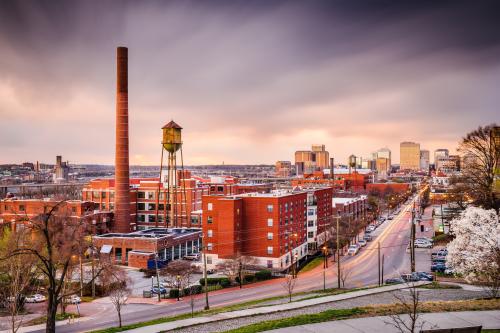As part of the American Rescue Plan Act, the U.S. Department of Commerce’s Economic Development Administration (EDA) recently launched a $1 billion Build Back Better Regional Challenge (BBBRC) grant to transform regional economies by investing in industry clusters that generate high-value, inclusive economic growth. The EDA expects to provide $500,000 planning grants to 50 to 60 regional finalists before investing $25 million to $75 million in 20 to 30 of those regions over several years.
Since nearly every region regularly identifies a set of “target industry clusters” in economic plans, most would appear well prepared to apply for these EDA grants. But as we found in our 2018 report, Rethinking Cluster Initiatives, the ubiquity of clusters as a concept masks the fact that transformative cluster initiatives are rare. Successful case studies indicate it will require rigorous strategic planning, large public and private investments, and significant industry engagement and leadership. And with equity being the EDA’s guiding principle, cluster coalitions must broaden to include and empower institutions and leaders with a track record of delivering economic opportunity to underserved communities.
“Building back better” through a major federal investment in equitable cluster development is possible—but will not be easy. To guide strategic planning, this blog outlines common cluster initiative pitfalls, five elements of sound implementation, and four new insights for regional leaders to consider as they apply to the Build Back Better Regional Challenge.
Cluster initiatives need a rethink
Regional economies grow and decline based on their ability to specialize in high-value industries and evolve those specializations over time. Especially for communities that have struggled through economic decline, industry clusters—groups of firms that gain a competitive advantage through local proximity and interdependence in areas such as talent and innovation—can be a compelling strategic framework. A clear body of evidence showing that firms and regions benefit from clustering has led to widespread adoption of cluster-oriented activities within the economic development field.
But a cursory look across today’s economic development landscape reveals a glaring gap: For all the compelling and widely accepted attention given to the concept of clusters over the past three decades, cluster initiatives in U.S. regions have, for the most part, failed to live up to their expected potential. There are many reasons for this, including the fact that many regions simply lack the resources and capacity to make multi-decade investments in the various factors (world-leading knowledge and advanced research, capital-rich entrepreneurship ecosystems, a deep talent pool, tailored infrastructure) that enable a cluster to take root and grow. While public officials cannot build clusters from scratch, federal or state investment clearly matters in influencing the market conditions for quality growth. The BBBRC will address this resource gap for winning regions, although likely not entirely.
Our 2018 report identified another problem that will prevent many regions from creating compelling applications for EDA funding. Regions almost always define clusters to celebrate and promote their economy or express aspirations—not as a basis for making hard decisions about how to invest limited resources. Regions typically identify six to eight “target industry clusters,” such as life sciences, advanced manufacturing, and logistics. On closer examination, these “targets” cover half or more of the entire economy (and are therefore not targeted enough to be impactful) and are typically the same targets that other regions claim as unique specializations (and are therefore not strategic enough to be impactful).
In short, the way that many regions think about and define their clusters makes it almost impossible to act strategically. Few regions have set themselves up to deliver what the EDA calls for in the BBBRC: “a purposeful approach to ambitious yet actionable economic transformation.”
Five traits of successful cluster initiatives
This gap inspired our 2018 report. Rather than delve into the technicalities of how to define clusters or offer a definitive playbook, we reviewed the literature, consulted cluster experts, and synthesized practical lessons from five ambitious, strategic, well-funded, and coordinated regional industry cluster initiatives. The five case studies at the core of the report were Milwaukee (water technology), St. Louis (agriculture technology), Syracuse, N.Y. (unmanned aerial systems), Upstate South Carolina (automotive), and the Central Indiana Corporate Partnership (which supports multiple clusters).
These case studies provide valuable insights and lessons for those applying for the BBBRC grants. They shed light on how these regions identified and prioritized their clusters, made the case for investment to numerous stakeholders, designed a portfolio of interventions, and created organizational structures capable of sustaining focus and managing the strategy’s evolution.
The report identifies five characteristics cluster initiatives need to be successful:
- A focus on establishing a robust ecosystem, which takes years. First and foremost, cluster initiatives must advance the growth and competitiveness of existing firms in the cluster (and related entities). Job growth and investment from companies outside the cluster eventually manifest, but not immediately. Initiatives must establish a robust and regenerating ecosystem that produces the innovation, talent, and economic opportunities that businesses—both existing and new—need to thrive. The jobs will ultimately follow, drawn by the gravity of the cluster.
- Industry-driven, university-fueled, and government-funded. The strongest clusters are driven by the private sector, with interventions catalyzed by groups of firms that believe they will benefit by collaborating to solve problems. Research universities provide needed innovation and talent, while federal, state, and local governments make major investments to support each initiative and provide early credibility. The most successful initiatives create an organization or “table” that enables actors from these sectors to do what the EDA seeks to accomplish via the BBBRC: develop a set of distinct projects “coordinated such that the result is more than the sum of their parts.”
- Placing a collective big bet on a unique opportunity. The most successful cluster initiatives are in regions with a long-term mindset and who are unafraid to “pick winners” from the array of potential alternatives. They recognize that the only way to distinguish themselves in an increasingly noisy marketplace is by funneling energy and investment into a limited number of unique specializations.
- Championed by passionate, dedicated leaders. Individual leaders—typically emerging from businesses operating within the sector—have proved invaluable in championing each successful cluster initiative. These are thought leaders who recognize a unique opportunity, craft a compelling narrative, and dedicate the time needed to launch and sustain a bold cluster initiative. Holding together “the table” that asks questions, makes decisions, and delivers shared investments typically requires sustained leadership from credible, charismatic leaders.
- Anchored by a physical center. While companies and assets involved in a cluster are often scattered throughout each region, a physical center provides a unifying space that facilitates knowledge spillovers and interaction between corporations, academic leaders, and new enterprises. It also provides a tangible example of the cluster’s relevance to the region. All this noted, while real estate can play an important role in cementing a cluster that is already robust, it cannot create a cluster on its own. Clusters may need industrial parks, but industrial parks do not make clusters.
Four new considerations for cluster initiatives
There are four important new factors to consider in this process that are not fully addressed in our 2018 report. First, rising economic inequality and a racial justice reckoning now mean that any cluster-based economic development effort must consider to whom clusters distribute opportunity—both through the labor market and entrepreneurship. Reflecting the Biden administration’s commitment to a fairer economy, equity is the number-one priority for the EDA.
Second, it is even more important that cluster initiatives are explicitly aimed at addressing global challenges—notably, climate change (as Milwaukee’s water cluster does).
Third, regional economic divergence means that it is getting harder and harder to develop viable growth clusters outside of the “superstar” metro areas. Urban-rural linkages will be a critical consideration to developing cluster dynamics at a scale to compete with the largest metro areas.
This leads to the fourth point: There are emerging and practical branches of research that might help regions strategically select optimal clusters, such as evolutionary economic geography, smart specialization, and complexity theory. These are academic concepts that have been applied by the European Union’s major cluster initiative and help regions understand how their startup scene and existing industrial base intersect with new digital technologies like artificial intelligence.
What is also new is that there is $1 billion in funding on the line for regions that can think clearly and strategically about cluster development. We encourage leaders who are part of a regional coalition planning to apply for the EDA’s BBBRC grant to read our 2018 report and accompanying case studies as part of the preparations.









Commentary
A new federal grant should make regional leaders rethink their industry clusters
September 1, 2021